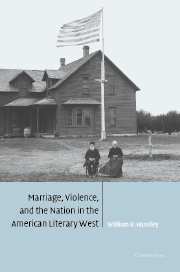Book contents
- Frontmatter
- Contents
- List of illustrations
- Acknowledgments
- Introduction
- 1 Western unions
- 2 Turner's rhetorical frontier
- 3 Marrying for race and nation: Wister's omniscience and omissions
- 4 Polygamy and empire: Grey's distinctions
- 5 Unwedded West: Cather's divides
- 6 Accident and destiny: Fitzgerald's fantastic geography
- 7 Promises and betrayals: Joan Didion and Wallace Stegner
- Afterword
- Notes
- Index
4 - Polygamy and empire: Grey's distinctions
Published online by Cambridge University Press: 22 September 2009
- Frontmatter
- Contents
- List of illustrations
- Acknowledgments
- Introduction
- 1 Western unions
- 2 Turner's rhetorical frontier
- 3 Marrying for race and nation: Wister's omniscience and omissions
- 4 Polygamy and empire: Grey's distinctions
- 5 Unwedded West: Cather's divides
- 6 Accident and destiny: Fitzgerald's fantastic geography
- 7 Promises and betrayals: Joan Didion and Wallace Stegner
- Afterword
- Notes
- Index
Summary
Like The Virginian, the immensely popular novels of Zane Grey had enormous influence on the development of the Western. Although Grey's work is best known for its formulaic elements such as the gunslinger, one of the curiosities for today's readers of his most influential and successful Western, Riders of the Purple Sage (1912), is the villain: a Mormon polygamist. Early reviewers noted the historical distinctiveness of his antagonist, but contemporary criticism of the novel has given it relatively little attention. Grey's first novel to deal with Mormons, The Heritage of the Desert (1910), like the 1915 sequel to Riders, is contrastingly sympathetic toward and understanding of Mormons, given his personal experience among them. The immediate cultural catalyst for Grey's reversion in Riders to a demonizing stereotype, which was arguably key to the novel's huge success, was an anti-Mormon magazine crusade in 1911 that Grey was well aware of and that revived paranoia about polygamy. I will discuss this crusade in the first section of this chapter, along with the cultural logic behind that immediate context: the history of Mormon and American tension that would make of that brief, revived fear of polygamy such a potent factor in the novel's reception. Far from being a substitutable figure in Grey's novel, the polygamous Mormon was a specific repository for Grey's readers, as it had been for decades for Americans, of the contradictions and anxieties inherent in American beliefs about racial and sexual identity (and the others such identity is constructed against) and of the relationship between the law and religious freedom.
- Type
- Chapter
- Information
- Publisher: Cambridge University PressPrint publication year: 2002

